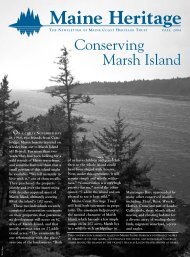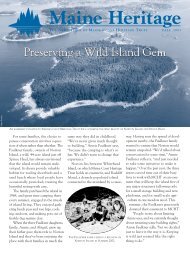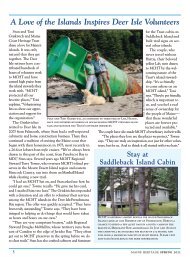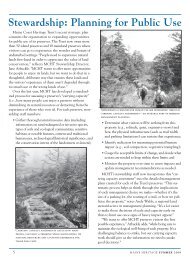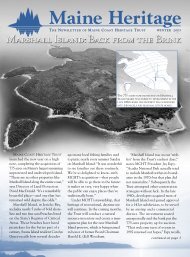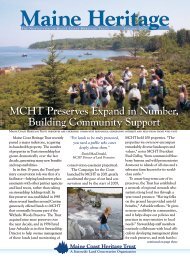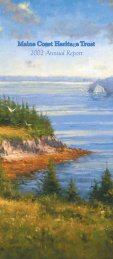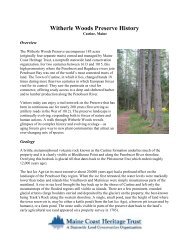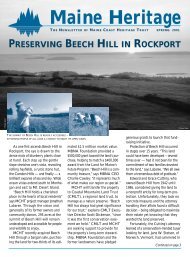Malaga Island - Maine Coast Heritage Trust
Malaga Island - Maine Coast Heritage Trust
Malaga Island - Maine Coast Heritage Trust
Create successful ePaper yourself
Turn your PDF publications into a flip-book with our unique Google optimized e-Paper software.
<strong>Malaga</strong> <strong>Island</strong><br />
An Overview of its Natural and Cultural History<br />
Where is <strong>Malaga</strong> <strong>Island</strong>?<br />
<strong>Malaga</strong> <strong>Island</strong> lies off Phippsburg in eastern<br />
Casco Bay, about 20 miles northeast of<br />
Portland, <strong>Maine</strong>. The sheltered, 42-acre<br />
island is at the mouth of the New Meadows<br />
River. Bear <strong>Island</strong> lies 100 yards to its west<br />
and the small fishing village of Sebasco is<br />
about 300 yards to the east.<br />
―<strong>Malaga</strong>‖ is the Abanaki Indian word for<br />
cedar. Previously known as ―Mitchell’s<br />
<strong>Island</strong>‖ (in the late 18 th century) <strong>Malaga</strong><br />
<strong>Island</strong> is sometimes called ―Malago‖ by local<br />
residents.‖<br />
The Natural History of <strong>Malaga</strong> <strong>Island</strong><br />
<strong>Malaga</strong> <strong>Island</strong> lies along a stretch of midcoast<br />
<strong>Maine</strong> characterized by elongated<br />
bedrock peninsulas separated by relatively<br />
deep, but narrow estuaries and inlets. The<br />
<strong>Malaga</strong> <strong>Island</strong><br />
New Meadows River by <strong>Malaga</strong> functions<br />
more as an embayment than a true estuary, since there is no substantial freshwater input to<br />
the river. The average tidal range in Casco Bay is 8.9 feet. At low tide, Bear <strong>Island</strong> and<br />
<strong>Malaga</strong> <strong>Island</strong> are linked by an intertidal bar.<br />
<strong>Malaga</strong> <strong>Island</strong> from Sebasco Village<br />
The topography of <strong>Malaga</strong> <strong>Island</strong>, as well as<br />
other islands and coastal lands in and around<br />
Casco Bay, is controlled by the underlying<br />
metamorphic bedrock of the region.<br />
Bedrock ridges extend north-south along the<br />
length of the island, with elevations ranging<br />
up to 40-60 feet above mean sea level.<br />
Glacial till, an unsorted mixture of sediments<br />
deposited by the late Pleistocene ice sheet<br />
over 10,000 years ago, forms the parent<br />
material of the island’s shallow soils.<br />
Bedrock outcrops are common on the island,<br />
especially on the ridgetops.<br />
<strong>Malaga</strong> <strong>Island</strong> - An Overview of its Natural and Cultural History<br />
<strong>Maine</strong> <strong>Coast</strong> <strong>Heritage</strong> <strong>Trust</strong> 1
<strong>Malaga</strong> <strong>Island</strong> is almost entirely forested by red spruce trees, many 85-90 years old. The<br />
spruce forest on the island today has likely originated from a pre-existing spruce forest that<br />
was selectively cut by <strong>Malaga</strong>’s former inhabitants. About two acres of mixed shrubs,<br />
grasses and wildflowers occurs on the northern end of the island where the historic<br />
community was located. Most of <strong>Malaga</strong>’s two miles of shoreline is bedrock ledge,<br />
interspersed with patches of salt marsh and a few pocket beaches.<br />
The only known rare plant on <strong>Malaga</strong> is spotted<br />
wintergreen (Chimaphila maculata), a plant<br />
listed as endangered in <strong>Maine</strong>. This small,<br />
evergreen perennial plant is located at the<br />
northern limit of its range, and is found primarily<br />
in southern <strong>Maine</strong>.<br />
Numerous wildlife species use island habitats<br />
in Casco Bay, including those on <strong>Malaga</strong><br />
<strong>Island</strong>. Mammals such as white-tailed deer,<br />
raccoons, red squirrels, and deer mice live on<br />
<strong>Malaga</strong> either as permanent residents or<br />
Spruce forest on <strong>Malaga</strong> <strong>Island</strong><br />
transients. <strong>Malaga</strong>’s mature conifer forest<br />
provides habitat for both resident and<br />
migratory birds such as black-throated green warbler, yellow-rumped warbler,<br />
blackburnian warbler, golden-crowned kinglet, and common raven. Other species, such<br />
as the song sparrow, nest in open shrubby edge habitat on the island.<br />
Bald eagles, recently delisted as a federally threatened species, have nested on nearby Bear<br />
<strong>Island</strong>. <strong>Malaga</strong> <strong>Island</strong> falls partly within the Essential Habitat for this bald eagle nest, a state<br />
designation that protects habitat within a ¼-mile radius<br />
(1,320 ft.) of the nest.<br />
Sea ducks and other seabirds, including eiders, terns, and<br />
common loons, feed in the surrounding waters, with gulls<br />
and ducks often gathering on the rock ledges on the<br />
southern end of the island. The tidal flats between <strong>Malaga</strong><br />
and Bear <strong>Island</strong>s are one of several important shellfish<br />
harvesting areas in the New Meadows River system.<br />
<strong>Malaga</strong>’s Human History<br />
Blackburnian warbler<br />
Native Americans inhabited <strong>Malaga</strong> <strong>Island</strong> within the last 1,000 years based on the findings<br />
of a recent archaeological survey by the University of Southern <strong>Maine</strong>. Although little is<br />
known about how these first inhabitants lived, considerably more is known about <strong>Malaga</strong>’s<br />
later residents – a mixed-race community that occupied the island’s north end from the mid<br />
1800s to 1912 when the State forcibly removed them.<br />
<strong>Malaga</strong> <strong>Island</strong> - An Overview of its Natural and Cultural History<br />
<strong>Maine</strong> <strong>Coast</strong> <strong>Heritage</strong> <strong>Trust</strong> 2
Most of the families that lived on <strong>Malaga</strong> had ancestral roots in <strong>Maine</strong> dating back 150 years<br />
or more, and moved in and out of island fishing communities for almost two centuries before<br />
settling on <strong>Malaga</strong> after the Civil War. Some of <strong>Malaga</strong>’s residents had previously lived as<br />
squatters on nearby islands, such as Bear, Yarmouth and Sheep <strong>Island</strong>s.<br />
Benjamin Darling, a slave from the West Indies, arrived in <strong>Maine</strong> in the late 18 th century<br />
with a Captain Darling to help establish a saltworks in the town of Phippsburg. In 1794, he<br />
was given his freedom and money to buy Horse <strong>Island</strong> after saving the Captain’s life during a<br />
shipwreck (Horse <strong>Island</strong>, known now as Harbor <strong>Island</strong>, is located about a half mile southeast<br />
of <strong>Malaga</strong> <strong>Island</strong>). His descendents later settled on various owned and unowned islands in<br />
eastern Casco Bay, and were among the first to reside on <strong>Malaga</strong>. Some have suggested that<br />
<strong>Malaga</strong>’s name may derive from the wreck of Captain Darling’s brig which was loaded with<br />
timber from <strong>Malaga</strong>, Spain.<br />
A Community Takes Root<br />
In 1818, Eli Perry, one of<br />
Phippsburg’s earliest settlers, bought<br />
<strong>Malaga</strong> <strong>Island</strong> for $150, but there is no<br />
evidence that the family ever paid<br />
taxes on the property. Although<br />
unconfirmed, <strong>Malaga</strong>’s first known<br />
resident, Henry Griffin, settled on the<br />
island’s east side in the early 1860s.<br />
The community on <strong>Malaga</strong> <strong>Island</strong><br />
A small community was established on<br />
<strong>Malaga</strong> within several years, with the Darlings and the Griffins, black families whose<br />
members were born free in the state of <strong>Maine</strong>, being the first to settle on the island. By 1880,<br />
27 people lived on the island, with the population increasing to 40 people in 1900. <strong>Malaga</strong><br />
family surnames included: Murphy, Griffin, Dunning, Johnson, Eason, Marks, McKenney,<br />
and Darling (the Tripp and Parker families arrived on the island later). James McKenney, a<br />
Phippsburg native of Scotch-Irish descent, acted as the literate spokesman and leader of the<br />
<strong>Malaga</strong> community. Because of his spokesman role and his reputation as the island’s best<br />
fisherman, McKenney was referred to as the ―King of <strong>Malaga</strong>.‖ John Eason was a master<br />
mason and carpenter who served as a<br />
preacher when weather prevented island<br />
residents from attending services at the<br />
mainland’s Nazarene church.<br />
A <strong>Malaga</strong> family and their home.<br />
<strong>Malaga</strong>’s community was racially mixed,<br />
consisting of poor African-American,<br />
mulatto, and white fishing families from the<br />
New Meadows area, as well as others of<br />
varied ethnic descent. <strong>Malaga</strong> was one of the<br />
last refuges for poor fishing families as island<br />
and coastal real estate elsewhere around<br />
Casco Bay was sold off.<br />
<strong>Malaga</strong> <strong>Island</strong> - An Overview of its Natural and Cultural History<br />
<strong>Maine</strong> <strong>Coast</strong> <strong>Heritage</strong> <strong>Trust</strong> 3
<strong>Malaga</strong>’s residents relied almost entirely upon local marine resources to sustain themselves.<br />
They caught groundfish using long-lines and nets from dories, and later turned to lobster<br />
fishing when groundfish stocks became depleted. They netted baitfish (herring) for income,<br />
picked berries in the summer, and dug clams from nearby tidal flats. The island itself did not<br />
support much in the way of agriculture, although islanders grew vegetables such as potatoes,<br />
corn and beans in small garden plots (although the island’s stony, glacial soils were generally<br />
unsuitable for cultivation). A few of <strong>Malaga</strong>’s residents worked on the mainland at nearby<br />
resorts and farms. The hardscrabble existence of <strong>Malaga</strong>’s residents was akin to those in<br />
many other coastal <strong>Maine</strong> fishing communities. By 1892, Phippsburg’s pauper relief fund<br />
began helping the islanders survive the winter months when fishing was less productive.<br />
Following the Civil War, racial prejudice, nativism<br />
(an ideology that sought to protect American<br />
citizens and culture from foreign threats), and the<br />
eugenics movement (which held that moral<br />
standards, income, and competency were linked to<br />
race, and that humans could be ―improved‖<br />
through selective breeding) became more dominant<br />
in the mainstream consciousness—affecting<br />
communities across the nation. Rumor mongers<br />
and reporters created fictionalized accounts of<br />
<strong>Malaga</strong>’s community, depicting residents as<br />
The McKenney home on <strong>Malaga</strong> <strong>Island</strong><br />
escaped southern slaves or the offspring of slaves<br />
and describing islanders as immoral, lazy, shiftless, ignorant, and alcoholic. An August 1905<br />
edition of the Casco Bay Breeze newspaper dubbed the island ―<strong>Malaga</strong>, the Home of<br />
Southern Negro Blood… Incongruous Scenes on a spot of Natural Beauty in Casco Bay.‖<br />
The poor condition of many of the islander’s homes offended some mainland residents and<br />
spoiled the view of newly arrived, wealthy, summer visitors. Phippsburg residents feared<br />
that conditions on <strong>Malaga</strong> might threaten the town’s chances to capitalize on the emerging<br />
tourist and summer cottage industry, which offered economic hope amidst declines in<br />
shipbuilding and depleted fish stocks.<br />
With social tensions on the rise,<br />
Phippsburg residents, led by Mr. C.V.<br />
Minott, argued that the island belonged to<br />
Harpswell. After a five-year ownership<br />
feud between the two towns, State<br />
legislators handed down a decision in<br />
1903 granting <strong>Malaga</strong> and nearby islands<br />
to Sagadahoc County and the town of<br />
Phippsburg. The town of Phippsburg was<br />
now more motivated than ever to rid itself<br />
of <strong>Malaga</strong>. The State subsequently<br />
repealed the decision in 1905, leaving the<br />
<strong>Malaga</strong> school students<br />
<strong>Malaga</strong> <strong>Island</strong> - An Overview of its Natural and Cultural History<br />
<strong>Maine</strong> <strong>Coast</strong> <strong>Heritage</strong> <strong>Trust</strong> 4
islanders wards of the State and under the jurisdiction of the Governor’s Executive Council.<br />
Tourists and missionaries frequently traveled the <strong>Maine</strong> coast in this era, dispensing religion<br />
and middle-class values wherever they went. George and Lucy Lane, and their daughter<br />
Cora, sea-going missionaries who summered on nearby Harbor <strong>Island</strong>, came to <strong>Malaga</strong> in<br />
1906 and established its first school in Mr. McKenney’s house.<br />
The Lane’s supporters formed the <strong>Malaga</strong> <strong>Island</strong> Settlement Association, which solicited area<br />
businesses, church groups, and civic-minded people for funds to further educate <strong>Malaga</strong>’s<br />
youth and instill in them middle-class values. With locally donated materials and funds, a<br />
new red schoolhouse was built in 1909. <strong>Malaga</strong>’s students received education in the three<br />
R’s, as well as drawing, music, geography,<br />
history and domestic training. By 1911, Evelyn<br />
Woodman and other teachers that worked on<br />
<strong>Malaga</strong> had made significant progress in<br />
educating the island’s children. A <strong>Malaga</strong><br />
education was thought by some to be better than<br />
that on the mainland, attracting at least one<br />
Phippsburg student to pay tuition to attend the<br />
school. The Lane’s supporters believed that<br />
<strong>Malaga</strong>’s future lay with its children and that<br />
education would allow them to better assimilate<br />
into a changing world.<br />
Eviction<br />
On July 11, 1911, Governor Frederick Plaisted and a group of state officials, landed on<br />
<strong>Malaga</strong> <strong>Island</strong> to meet its residents and inspect their homes. The Governor lauded <strong>Malaga</strong>’s<br />
new school—whose students serenaded him with a hymn—and later reported to The<br />
Brunswick Record that ―the people cannot be forced to leave their poor homes.‖<br />
Yet shortly after the Governor and his entourage toured the island, the State announced that<br />
the heirs of Eli Perry owned <strong>Malaga</strong> <strong>Island</strong> (although later research found no deed<br />
confirming their ownership). Within three weeks of the Governor’s visit, the Perry’s issued<br />
eviction orders to the ―<strong>Malaga</strong>ites‖ who had inhabited the island for more than a halfcentury,<br />
demanding they vacate the island by July 1, 1912.<br />
The State’s eviction strategy<br />
included an assessment of each<br />
resident’s household and their<br />
physical, mental, and financial<br />
condition. Those deemed ―feeble<br />
minded,‖ at least eight <strong>Malaga</strong><br />
residents in all, were dispatched to<br />
the recently built Home for the<br />
Feeble-Minded in New Gloucester.<br />
<strong>Malaga</strong>’s schoolhouse<br />
Governor Plaisted and state officials visit <strong>Malaga</strong> in July 1911<br />
<strong>Malaga</strong> <strong>Island</strong> - An Overview of its Natural and Cultural History<br />
<strong>Maine</strong> <strong>Coast</strong> <strong>Heritage</strong> <strong>Trust</strong> 5
The State promptly purchased the island for $471 to prevent people from resettling the island<br />
and appropriated a nomimal sum to pay off the remaining families, provided they vacated the<br />
island by July.<br />
Burial marker at Pineland Cemetery<br />
Some <strong>Malaga</strong> families moved their houses to<br />
the mainland or other islands, though others<br />
could find no refuge away from <strong>Malaga</strong>.<br />
Any structures not removed by eviction day<br />
were razed to discourage residents from<br />
returning—except for the new schoolhouse<br />
(which was moved in 1912 to Louds <strong>Island</strong><br />
in Muscongus Bay). In a final act of<br />
irreverence, the remains of <strong>Malaga</strong>’s<br />
deceased were exhumed in 1912 and reinterred<br />
at the Pineland Cemetery in New<br />
Gloucester.<br />
In 1913, the State sold <strong>Malaga</strong> <strong>Island</strong> to Everard A. Wilson, a friend of Dr. Gustavus Kilgore<br />
(who chaired Governor Plaisted’s three-member Executive Council committee charged with<br />
investigating the conditions on <strong>Malaga</strong> shortly after the governor took office in 1911). Since<br />
then, <strong>Malaga</strong> <strong>Island</strong> has changed hands numerous times. Local fishermen have used the<br />
island for decades to store fishing gear and traps, but no one has built significant structures<br />
there in the last century. All that now remains of <strong>Malaga</strong>’s historic community are the<br />
tombstones at Pineland, the schoolhouse at Louds <strong>Island</strong>, and a few stone-lined wells hidden<br />
by overgrown brush and weeds. Lottie Marks Blackwell, one of the last living residents of<br />
<strong>Malaga</strong> <strong>Island</strong>, died in 1997, at the age of 103.<br />
<strong>Malaga</strong> Today<br />
In 2001, <strong>Maine</strong> <strong>Coast</strong> <strong>Heritage</strong> <strong>Trust</strong> (MCHT)<br />
purchased <strong>Malaga</strong> <strong>Island</strong> at a generous<br />
bargain sale price to protect the island from<br />
development, foster low-impact recreation,<br />
and sustain the long tradition of island use by<br />
local fishermen. MCHT’s ownership of<br />
<strong>Malaga</strong> includes a 15-foot-wide right-of-way<br />
easement on the mainland to provide shore<br />
access from Bakers Wharf Road extension.<br />
The easement allows vehicle parking for four<br />
cars and storage for four dinghys.<br />
Lobster traps on <strong>Malaga</strong> <strong>Island</strong><br />
Local lobstermen use <strong>Malaga</strong> <strong>Island</strong> for<br />
storing traps, buoys and gear (with up to several thousand lobster traps during winter and<br />
fewer traps during summer). Recreational visitors to the island are almost exclusively local<br />
picnickers and small boat owners exploring local waters on day trips.<br />
<strong>Malaga</strong> <strong>Island</strong> - An Overview of its Natural and Cultural History<br />
<strong>Maine</strong> <strong>Coast</strong> <strong>Heritage</strong> <strong>Trust</strong> 6
Archaeological research at <strong>Malaga</strong> began with a reconnaissance survey in 1989 by University<br />
of Southern <strong>Maine</strong> (USM) researchers. USM’s summer archaeology field school has<br />
conducted additional research on the island’s northern end each year since 2002. Beginning<br />
in 2006, teams excavated several test pits to better understand the lifeways of <strong>Malaga</strong>’s<br />
historic inhabitants. Field research has focused on examining shell midden deposits at the<br />
site of the historic community and conducting artifact surveys on the adjacent tidal flats.<br />
Researchers have recovered approximately 50,000 artifacts including bone (mostly fish),<br />
ceramics, pipestems, leather, nails, fishhooks, coins, etc., dating from roughly 1880 to 1912.<br />
The historic footprints of the former<br />
house sites and the schoolhouse have been<br />
located, as well as stone-lined wells.<br />
Shell midden deposits on the island’s<br />
north end are relatively extensive, and<br />
represent not only historic waste dumps<br />
but created additional living surfaces for<br />
the islanders and foundations for their<br />
homes. <strong>Malaga</strong> <strong>Island</strong> is noteworthy in<br />
archaeological and environmental history<br />
because it contains specific household<br />
sites that can be matched to individual<br />
African-Americans for a specific time<br />
Archaeological research on <strong>Malaga</strong> <strong>Island</strong><br />
period.<br />
Since 2001, MCHT has managed <strong>Malaga</strong> <strong>Island</strong> for traditional uses, low-impact daytime<br />
recreation, and wildlife habitat. MCHT sponsors periodic interpretive field trips to the<br />
island, and people may visit on their own. The beach on the island’s north end is the<br />
safest place to land and allows easy access to a new loop trail cleared in Fall 2008. A<br />
MCHT preserve sign by the beach notes guidelines for use:<br />
Carry out all trash (including human and pet waste and toilet paper as there are no<br />
visitor facilities)<br />
Keep pets under control<br />
No camping or fires allowed<br />
MCHT completed a management plan for <strong>Malaga</strong> <strong>Island</strong> in 2009 with input from various<br />
stakeholders and the local community. The plan identifies the island’s most important<br />
natural and cultural features, significant threats to its conservation values, and actions MCHT<br />
will take to protect its resource values. The plan also highlights strategies for interpreting<br />
<strong>Malaga</strong>’s rich cultural and natural heritage for the general public and local and regional<br />
schools.<br />
<strong>Malaga</strong> <strong>Island</strong> - An Overview of its Natural and Cultural History<br />
<strong>Maine</strong> <strong>Coast</strong> <strong>Heritage</strong> <strong>Trust</strong> 7
A <strong>Malaga</strong> Reference List<br />
1. Barry, William David, 1980. The Shameful Story of <strong>Malaga</strong> <strong>Island</strong>. Down East,<br />
November 1980, pp.53-58, 83-84.<br />
2. Bower, Beth Ann, undated. African American Family History Resources at New<br />
England Historic Genealogical Society (NEHGS) - The Lane scrapbooks.<br />
(http://www.newenglandancestors.org/education/articles/research/special_topics/african<br />
_american/african_american_nehgs.asp)<br />
3. Breed, Allen G., 2001. Living in the North Gave Blacks No Guarantee Against Land<br />
Grabs (http://www.hartford-hwp.com/archives/45a/392.html)<br />
4. Cover, Susan M., 2007. Plaisted’s term a painful legacy – <strong>Malaga</strong> <strong>Island</strong> evictions a<br />
dark legacy. Kennebec Journal, August 27, 2007<br />
5. Debrule, Deborah, 2007. Digging for Truth – <strong>Malaga</strong> excavations reveals the lives of<br />
an island’s evicted residents. The Working Waterfront (Feb 26, 2007).<br />
6. Debrule, Deborah, 2007a. <strong>Malaga</strong>, revisited: One a Casco Bay island, a shameful<br />
incident in <strong>Maine</strong>’s history comes to light. The Working Waterfront (Feb 26, 2007).<br />
7. Debrule, Deborah. 1999. Evicted – How the state of <strong>Maine</strong> destroyed a “different”<br />
island community. <strong>Island</strong> Journal, Vol. 16<br />
8. Debrule, Deborah (undated). <strong>Malaga</strong> <strong>Island</strong> (summary of island tour, June 25)<br />
9. Goodale, W. 2008. Distribution of birds on 23 <strong>Maine</strong> <strong>Coast</strong> <strong>Heritage</strong> <strong>Island</strong>s. BRI<br />
report number 2008-04. Submitted to <strong>Maine</strong> <strong>Coast</strong> <strong>Heritage</strong> <strong>Trust</strong>. BioDiversity<br />
Research Institute, Gorham, <strong>Maine</strong>.<br />
10. Hamilton, Nathan, and Robert Sanford. 2006. <strong>Malaga</strong> <strong>Island</strong> Archaeology Project<br />
(<strong>Malaga</strong> <strong>Island</strong> Area Count Summary, Unit Count Summary by Level and Catalog<br />
Numbers Assigned to Artifact Lots from Surface Collections and 2006 STP and TU<br />
Excavations). Prepared for <strong>Maine</strong> <strong>Coast</strong> <strong>Heritage</strong> <strong>Trust</strong> and <strong>Maine</strong> Historic<br />
Preservation Commission. August 2006.<br />
11. Heflich, Adrienne, et al., Abstract: <strong>Malaga</strong> <strong>Island</strong> – A Brief History. Compiled by<br />
students of ES203 Service Learning Project.<br />
12. Heflich, Adrienne, et al., 2003. A social history of <strong>Malaga</strong> <strong>Island</strong>. Service Learning<br />
Project, ES 203, May 12, 2003.<br />
13. <strong>Malaga</strong> <strong>Island</strong> Project, (undated). <strong>Malaga</strong> <strong>Island</strong> Time Line, Discovering <strong>Malaga</strong><br />
<strong>Island</strong>, African American History in <strong>Maine</strong>.<br />
14. <strong>Malaga</strong> powerpoint – Cruise line vantage points relative to the north end of <strong>Malaga</strong><br />
<strong>Island</strong> (author unknown)<br />
15. Mitchell, Steve. 1999. The Shame of <strong>Maine</strong> – the forced eviction of <strong>Malaga</strong> <strong>Island</strong><br />
residents.<br />
16. Mitchell, Steve. 1999. The Shame of <strong>Maine</strong>, <strong>Malaga</strong> – The story behind the pictures.<br />
17. Sanford, Robert, Ph.D., and Nathan D. Hamilton, Ph.D. (date). Historical<br />
Archaeology of the <strong>Malaga</strong> <strong>Island</strong> Fishing Community, New Meadows River, Casco<br />
Bay. Powerpoint presentation at the 50th Anniversary Meeting of the <strong>Maine</strong><br />
Archaeology Society, Inc., Gorham, <strong>Maine</strong>.<br />
18. Mosher, John P., 1991. No Greater Abomination: Ethnicity, Class and Power<br />
Relations on <strong>Malaga</strong> <strong>Island</strong>, <strong>Maine</strong>, 1880-1912. Master’s thesis, University of<br />
Southern <strong>Maine</strong> (New England Studies).<br />
<strong>Malaga</strong> <strong>Island</strong> - An Overview of its Natural and Cultural History<br />
<strong>Maine</strong> <strong>Coast</strong> <strong>Heritage</strong> <strong>Trust</strong> 8
19. Mosher, John P., 1992. <strong>Malaga</strong> <strong>Island</strong> Archaeology Project: Report of the 1992 Field<br />
Season. A final report submitted to the <strong>Maine</strong> Historic Preservation Commission.<br />
University of Southern <strong>Maine</strong>, Department of Geography-Anthropology. October 30,<br />
1992.<br />
20. Price, H.H., and Gerald E. Talbot, 2006. ―No longer a Reproach: The Story of <strong>Malaga</strong><br />
<strong>Island</strong>,‖ by Allen G. Breed; in <strong>Maine</strong>’s Visible Black History, edited by H.H. Price and<br />
Gerald E. Talbot, pp. 69-75, Tilbury House Publishers, Gardiner, <strong>Maine</strong>. 2006.<br />
21. Schmidt, G.D., 2004. Lizzie Bright and the Buckminster Boy. NY: Clarion Books<br />
(Note: Schmidt’s fictionalized account of life on <strong>Malaga</strong> <strong>Island</strong> and in the nearby town<br />
of Phippsburg does not accurately reflect many actual historical events.)<br />
22. Staples, Joseph K., 2008. Natural Resource Inventory of <strong>Malaga</strong> <strong>Island</strong>, Phippsburg,<br />
<strong>Maine</strong>. For: <strong>Maine</strong> <strong>Coast</strong> <strong>Heritage</strong> <strong>Trust</strong>.<br />
23. Thomas, Miriam Stover, 1973. Flotsam and Jetsam. Pockets of Poverty: <strong>Malaga</strong> <strong>Island</strong>.<br />
24. University of Southern <strong>Maine</strong>, 2007. Synopsis: GYA 300 <strong>Malaga</strong> <strong>Island</strong> Field School,<br />
June 2007. University of Southern <strong>Maine</strong>.<br />
<strong>Malaga</strong> <strong>Island</strong> - An Overview of its Natural and Cultural History<br />
<strong>Maine</strong> <strong>Coast</strong> <strong>Heritage</strong> <strong>Trust</strong> 9



